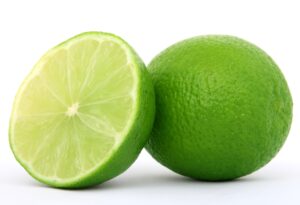Botanical Name – Citrus aurantifolia
Family – Rutaceae
Ch. No. – 2n = 18
Origin – India
Fruit type– Hesperidium
Inflorescence type – Cymose (Solitary)
Edible part – Juicy Placental Hairs
Watch Lecture Video
- India ranks 5th among the major lime and lemon-producing countries in the world.
- In 2018-19, the area under lime and lemon in India was 296 thousand hectares and the production was 3397 thousand metric tonnes.
- In 2018, Gujarat has the maximum area and production of lemon and lime (46.28 thousand hectares and 605.62 thousand metric tons) followed by Andhra Pradesh (34.88 thousand hectares and 562.01 thousand metric tons).
- Kagzi lime is an indicator plant for Tristeza and is highly susceptible to the disease.
- Citrus canker is the most serious disease of acid lime.
- Acid lime is a tropical plant.
- Gajanimma (Citrus pennivesiculata) and rough lemon are the most promising rootstocks of acid lime.
- The classification of citrus was given by Tanka and Swingle (1945).
- Spain is the largest exporter of citrus.
- The ultra-dwarf rootstock of citrus is Flying Dragon.
Varieties
- Pramalini – Canker tolerant
- Vikram

Acid Lime - Chakradhar – The seedless variety of acid lime
- P K M – 1
- Sai Sarbati – Tolerant to Tristeza and Canker
- Jai Devi – Pleasant Aroma
Climate
- Tropical climate
- Cultivated up to an altitude of 1000 m or so elevation.
- Strong wind and cold are harmful to its cultivation.
- The average annual rainfall should not exceed 75 cm.
Soil
- Well-drained, deep (1.5 m), medium to light soil is suitable.
Propagation
- Mainly done by seed.
Planting
- In the summer season, 60-75 cm3 sized pits are dug.
- Lime is planted at a distance of 5×5 or 6×6 meters.
- The best time for planting is the onset of monsoon.
Manure and Fertilizers
- FYM – 50 kg, N : P: K – 500 gm: 400 gm: 900 gm/tree from the 5th year onwards.
- Every year it is given for the first time in spring before flowering in December-January and the second dose in June-July.
Irrigation
- At an interval of 15-20 days in winter and at an interval of 8-10 days in summer.
- Adequate soil moisture should be maintained during fruit formation and fruit development.
Interculture and Intercropping
- Weeding once or twice a year (after monsoon)
- Legumes or some vegetables can be taken in the early stages of growth.
Training and pruning
- Training is done in the initial stage, and if necessary support is provided with bamboo sticks.
- Later pruning of unwanted branches of the trees can be done.
Flowering and Fruiting
- The tree starts flowering in the fourth year after planting.
- The fruits ripen six months after flowering.
- Spraying of ZnSo46% + 2, 4-D 20 ppm in early January results in more fruit setting, minimum fruit drop, and higher fruit yield.
Harvesting
- In Gujarat, 60% of the total crop is harvested from July to September, 30% from October – January, and 10% from February to May.
- In North India Harvesting is done from August – September.
- Fruits are harvested when the rind colour changes from green to yellow.
Yield
- The yield depends on the variety of lemon trees and can range from 150-500 quintals per hectare.
- And the average yield is 25t/ha
Difference between lime and lemon
|
Lime |
Lemon |
|
Botanically, it is C. aurantifolia |
Botanically, it is C. limon |
|
Leaves and flowers are small |
Medium size |
|
Marked petiole wings |
Petiole wings very narrow or absent |
|
Stamens are around 25 |
Stamens are around 30 |
|
Peel is very thin |
Medium thick |
|
Pulp vesicles are small and thin |
Comparatively big and thick |
|
Pulp greenish in appearance |
Pale yellow in an appearance |
References cited
- Commercial Fruits. By S. P. Singh
- A text book on Pomology, Vol,1. by T. K. Chattapadhya
- Tropical Horticulture, Vol.1, by T. K. Bose, S. K. Mitra, A. A. Farooqui and M. K. Sadhu
